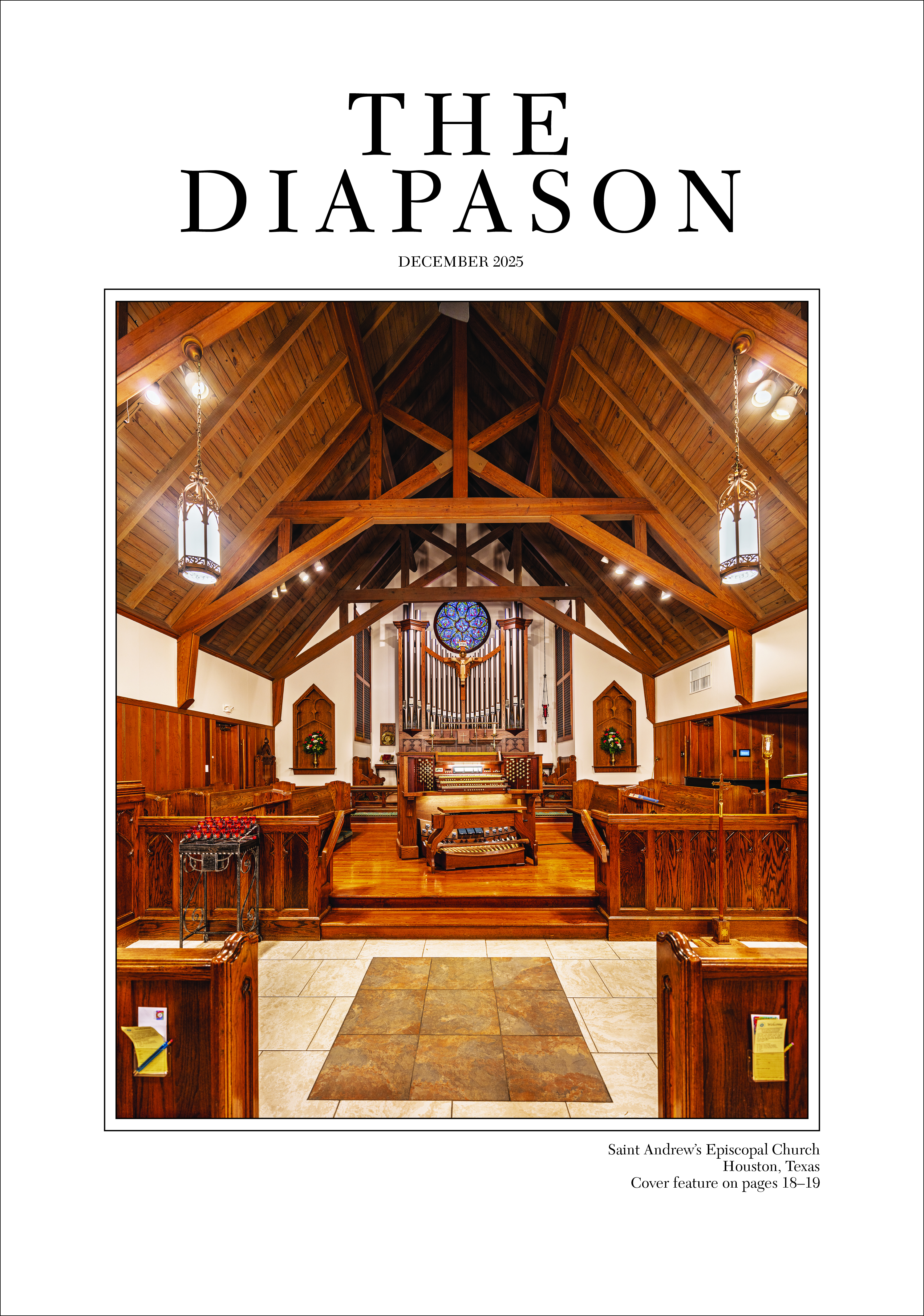
Marceau Pipe Organ Builders, Inc., Seattle, Washington
Community United Methodist, Church, Coeur d’Alene, Idaho
Marceau Pipe Organbuilders, Inc., has completed its Opus 36 for Community United Methodist Church of Coeur d’Alene, Idaho. The organ is significantly influenced by its rather extensive history of over 100 years, incorporating vintage sounds blended with new windchests and a modern digital electrical system.
The original organ for this church was built by the Estey Organ Company of Brattleboro, Vermont, and installed in the congregation’s first sanctuary in downtown Coeur d’Alene. The first major renovation project took place in 1978 when M. P. Möller of Hagerstown, Maryland, added a new Great division along with a new two-manual drawknob console. When the church moved to a new location, the organ was brought along and installed in two chambers above the main floor. This new building, the first phase of a long-range set of plans, was to become the gymnasium with a new sanctuary planned for the second phase. Unfortunately, these goals were never realized, and Celebration Hall has continued to do double duty for over forty years.
Our first visit to the church took place in 1997 for service work. While the organ was in good playing condition, we noticed some early signs of age-related problems to the windchests. The organ utilized the original Estey and Möller windchests of 1978, and some home-built units that accommodated the unit stops. The electrical system was an electro-mechanical unit from 1978. During the next fifteen years, the problems became more frequent and expensive to repair. Going hand-in-hand with that was a tonal design that was unable to support and lead congregational singing.
It was at this point that the church approached us about some possible solutions to the status of the organ. After several meetings we were able to develop an overall plan to improve the capabilities of the organ that could be realized with the modest budget that was available.
We felt that the existing windchests took up too much floor space, making it impossible to contemplate any meaningful tonal changes or additions. New windchests were built in the Marceau shop that would fit in the limited floor space below an angled ceiling. With that change, the possibility of tonal additions was investigated. The 1978 Möller console was in good condition; the shell was retained with new keyboards, new drawknob units, and a Syndyne control system.
A look at the stoplist reveals two distinct principal choruses, one on the Great and the other on the Swell. The Great retains the Principal stops (Möller at 8′ and 4′) with the addition of a 2′ Super Octave and IV Mixture from Marceau inventory. The Swell retains the 8′ Violin Diapason (Estey) and the existing Great Mixture (Möller, recomposed for greater color and clarity), adding a 4′ Geigen Principal (Reuter). Also in the Great, an Open Diapason (Austin) was added for foundational support at 8′ pitch.
The flutes bring a variety of color and dynamic contrast. The Great retains the 8′ Rohrflute (Möller), adding a 4′ Spillflute from Marceau inventory. The Swell is a blending of Estey pipework (8′ Holzgedeckt and 4′ Harmonic Flute) and Möller ranks (22⁄3′ Nasard, 2′ Blockflute, and 13⁄5′ Tierce—which was the 2′ Flute, repitched). The Pedal 16′ Subbass is from Marceau inventory, replacing the original Estey pipes that had experienced unsuccessful previous repairs from cracks in the wood.
The strings bring a varied set of colors and character. The Great 8′ Viol d’Amour (Estey) is relocated from the Swell. The Swell 8′ Salicional and 8′ Voix Celeste (Reuter) add an orchestral character that the previous instrument did not have.
The Swell Trumpet (Austin) is extended to play at 16′ in the Pedal. The 8′ Oboe (of unknown origin) was from the previous organ; this rank was thoroughly repaired and regulated to be the dynamic and character counterpart to the Trumpet.
The organ was dedicated on November 11, 2018. We are indebted to the leadership of Mark Habermann, whose presence and support helped to make this project a true success. He chaired the organ committee, coordinated all church help, and provided food and lodging during our on site visits.
—René A. Marceau, president and tonal director
Sean Haley, operations manager
Marceau Pipe Organ Builders, Inc.
Builder’s website:
Church website: www.cdaumc.org
GREAT (Manual I, unenclosed)
16′ Lieblich Gedeckt (Sw)
8′ Open Diapason 61 pipes
8′ Principal 61 pipes
8′ Rohrflute 61 pipes
8′ Viol d’Amore 61 pipes
4′ Octave 61 pipes
4′ Spillflute 61 pipes
2′ Super Octave 61 pipes
11⁄3′ Mixture IV 244 pipes
8′ Trumpet (Sw)
Chimes
SWELL (Manual II, enclosed)
16′ Lieblich Gedeckt (ext 8′)
8′ Violin Diapason 61 pipes
8′ Holzgedeckt 73 pipes
8′ Salicional 61 pipes
8′ Voix Celeste (TC) 49 pipes
4′ Geigen Principal 61 pipes
4′ Harmonic Flute 61 pipes
22⁄3′ Nasard 61 pipes
2′ Blockflute 61 pipes
13⁄5′ Tierce 61 pipes
2′ Mixture III 183 pipes
8′ Trumpet 61 pipes
8′ Oboe 61 pipes
Tremulant
PEDAL (Unenclosed)
32′ Resultant
16′ Subbass 32 pipes
16′ Lieblich Gedeckt (Sw)
8′ Diapason (Gt)
8′ Gedecktbass 32 pipes
8′ Holzgedeckt (Sw)
4′ Choralbass (Gt)
4′ Flute (Sw)
16′ Posaune (Sw)
8′ Trumpet (Sw)
4′ Clarion (Sw)
27 ranks, 1,589 pipes

